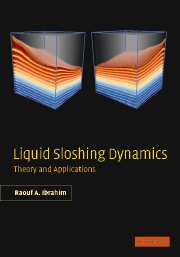Book contents
- Frontmatter
- Contents
- Foreword
- Acknowledgment
- Introduction
- Part I Linear sloshing dynamics
- 1 Fluid field equations and modal analysis in rigid containers
- 2 Linear forced sloshing
- 3 Viscous damping and sloshing suppression devices
- Part II Nonlinear and parametric sloshing dynamics
- Part III Sloshing – structure interaction
- Part IV Rotating fluid and low gravity sloshing
- References
- Index
2 - Linear forced sloshing
from Part I - Linear sloshing dynamics
Published online by Cambridge University Press: 11 August 2009
- Frontmatter
- Contents
- Foreword
- Acknowledgment
- Introduction
- Part I Linear sloshing dynamics
- 1 Fluid field equations and modal analysis in rigid containers
- 2 Linear forced sloshing
- 3 Viscous damping and sloshing suppression devices
- Part II Nonlinear and parametric sloshing dynamics
- Part III Sloshing – structure interaction
- Part IV Rotating fluid and low gravity sloshing
- References
- Index
Summary
Introduction
The previous chapter treated the free oscillations of liquid free surface in different container geometries. The fluid field equations were developed and the natural frequencies were determined from the free-surface boundary conditions. The knowledge of liquid-free-surface natural frequencies is important in the design of liquid containers subjected to different types of excitations. In the design process, it is important to keep the liquid natural frequencies away from all normal and nonlinear resonance conditions. The excitation can be impulsive, sinusoidal, periodic, or random. Its orientation with respect to the tank can be lateral, parametric, pitching/ yaw, roll, or a combination. Under forced excitation, it is important to determine the hydrodynamic loads acting on the container, and their phase with respect to the excitation. The hydrodynamic forces are estimated by integrating the pressure distribution over the wetted area. One should also determine the free-surface wave height, which affects the location of the center of mass. In the neighborhood of resonance, the free surface experiences different types of nonlinear behavior and this will be considered in Chapters 4, 6, and 7.
Under impulsive excitation, liquid sloshing dynamics was studied by Morris (1938), Werner and Sundquist (1949), Jacobsen (1949), Jacobsen and Ayre (1951), and Hoskins and Jacobsen (1957). Bauer (1965a) considered the response of liquid propellant to a single pulse excitation. Transient and steady state response to sinusoidal excitation of a liquid free surface was studied by Sogabe and Shibata (1974a, b).
- Type
- Chapter
- Information
- Liquid Sloshing DynamicsTheory and Applications, pp. 88 - 155Publisher: Cambridge University PressPrint publication year: 2005

